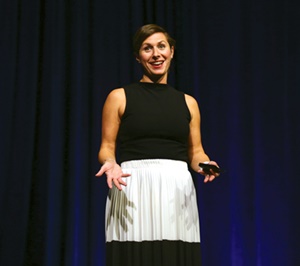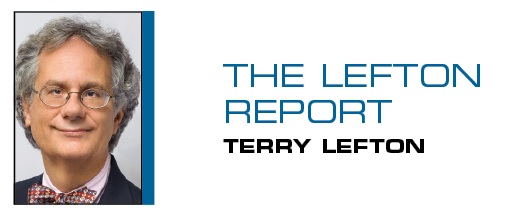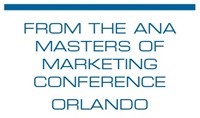 |
Photo by: CLARION PICTURES (3)
|
“Products can be replicated. Experiences are much more difficult to attack.”
JIM SPEROS
EXECUTIVE VICE PRESIDENT, FIDELITY INVESTMENTS
With digital advertising having lost luster and credibility after recent revelations of fraud along the “digital advertising supply chain,” the 2,700 marketers gathered in Orlando recently for the Association of National Advertisers annual confab got back to basics: the value of great creative, regardless of medium.
“It’s really no wonder we’re seeing ad blocking,” said Procter & Gamble Chief Brand Officer Marc Pritchard, cautioning fellow marketers not to fall victim to the “content crap trap,” fostered by the necessity to feed multiple digital distribution channels with content.
“Too often we produce crap,” Pritchard said, before screening some P&G work which certainly fit that description. “Craft or crap? That’s our creative challenge. Technology actually enables both. … It’s time to insist that all media partners adopt common, transparent measurement standards and accept third-party verification. We need to stop wasting time on measurement transactions and invest in what’s really important: elevating the craft.”
So while internet-enabled disruption was still a big issue, a focus on better creative surpassed it this time around.
Jim Speros, Fidelity Investments executive vice president, cited research saying that in 2015, creativity was listed as the 10th most important job skill. By 2020, it’s expected to be the third most important. He asked that marketers shift focus “from products to experiences, because products can be replicated. Experiences are much more difficult to attack.”
Speros received a standing ovation from the ANA crowd after he announced that he was retiring at year’s end. He has worked as a marketer for 40 years, for brands including AT&T, Ernst & Young and for the last eight years with Fidelity.
Digital marketing evangelist Gary Vaynerchuk nonetheless fired a tracer bullet at the audience, many of whom were trained as traditional marketers.
“If you think Uber and Airbnb and all the direct-to-consumer brands are going to love the subjectivity of creative or the horseshit [digital media] reporting that’s being accepted with this ecosystem, you are out of your mind,” he said.
Still, the skepticism surrounding digital media was repeatedly expressed at the conference by America’s biggest media spenders.
“We were on a [digital ad-buying] tear, but with everything that we’ve all learned about the digital media supply chain, we’re holding,” said McDonald’s CMO Deborah Wahl, whose company produces an astounding 5,000 pieces of content annually to fill the digital chasm. “I don’t want to invest a lot more in that until we all get more confident about what it is.”
Fueling marketers’ distaste for digital media were examples of malfeasance, like Facebook, which earlier admitted to overstating video ad consumption on some of its pages by as much as 80 percent. Agency Dentsu acknowledged some digital overcharges in excess of 100 percent.
“In an era where technology rules, does it really require this unintelligible digital media supply chain to deliver a simple ad?” said ANA President and CEO Bob Liodice. “Marketers must take their industry back.”
Outgoing ANA Chairman and former Subway CMO Tony Pace posed a salient question.
 |
MasterCard Chief Marketing Officer Raja Rajamannar says millennials “want to be delighted routinely. They want to constantly be rewarded.”
|
“Growth for most [consumer marketers] is 2 percent at best,” Pace said. “Is that because digital is ineffective? I don’t have the answer, but that’s one of the discussion points I keep hearing here.”
MasterCard CMO Raja Rajamannar noted that it’s impossible to ignore the more than 8.1 billion internet-connected devices — a number larger than the earth’s population. Consequently, he advocated the establishment of marketing departments combining the old and new principles. “Classical CPG marketing, where you understand consumer segmentation and behavior is critical,” he said. “Contemporary marketers are constantly testing and changing with data and digital. What you need is both.”
With 25 years in marketing, Johnson & Johnson CMO Alison Lewis reminded colleagues that even after all the changes wrought by digital and mobile technology, there are still opportunities there.
“Consumers still want the physical, but they operate in the digital,” Lewis said. “We’ve got to bring those things together. While some will argue that television is dead, time spent on television is almost the same over the past five to seven years. But the total number of minutes consuming media has increased dramatically, so we have to be in so many more places.”
Verizon CMO Diego Scotti also called for better work, noting that the annual ad spend across the U.S. was 10 times that of NASA’s total budget. “NASA’s sending a ship to Mars. Are you telling me what we’re doing is 10 times more difficult?” he asked.
In his 35-minute presentation, Scotti encouraged marketers at even the biggest organizations to avoid “echo chamber” marketing by adding disparate voices. “The more you try to control everything, the less you control,” he said. “The more perspectives you bring from inside and outside of your company, the better.”
Simultaneous with the growth of internet connectivity and accompanying calls for corporate transparency is a higher level of consumer expectation, especially millennials.
“They want to be delighted routinely,” said MasterCard’s Rajamannar. “They want to be constantly rewarded. … There’s a feeling of entitlement there.”
As for conclusions? It was a mixed message for many.
“You’ve got some people here saying that the best creative really drives business, and you’ve got others saying the entire advertising model is broken,” said John Osborn, president and CEO, BBDO, New York. “The truth is somewhere in between. Marketers that are thriving are the most agile ones, so speed to market, speed to execution and speed to ideas are the most important things I’m taking from here.”
> FACEBOOK’S FORECAST: Digital advertising concerns aside, a series of compelling data points from Facebook North America marketing head Michelle Klein had marketers across categories hitting their “like” buttons. While Marketing 101 says ad dollars inevitably follow eyeballs, domestic marketing budgets have not come close to keeping pace with consumers’ voracious use of mobile devices. Consequently, Facebook’s Klein was nonetheless advocating a “mobile-first” marketing strategy for all marketers.
 |
Facebook North America marketing head Michelle Klein advocates a “mobile-first” strategy for all marketers.
|
Her rationale? The average adult checks his or her smartphone 30 times a day. For those under 21, it’s a 157-times-a-day habit. This is a group that regularly wrestles with “nomophobia,” the fear of not having your mobile device.
Klein also cited studies saying that 78 percent of adults have their mobile devices with them 22 hours a day. It’s a powerful addiction: Another study found that 25 percent of those surveyed would consider having their handheld mobile devices replaced by one surgically implanted. Another head-turner: 31 percent of smartphone users don’t use them for voice calls during the work week.
Perhaps that’s because six of the most popular downloaded apps worldwide are messenger apps.
“I don’t know why we even call it a phone anymore,” Klein said. “Messaging is something marketers need to pay attention to. It’s scalable, real-time and it still feels personal.”
Marketers also need to prepare themselves, she said, for a time when 75 percent of internet traffic will be mobile video. According to Klein, that time is just four years away. “We need to start thinking now about mobile video in our marketing,” she said.
As wired as the world is, half of the earth’s population still doesn’t have internet access, Klein reminded her well-connected audience of marketers. “When the whole world is connected, imagine the stories we’ll tell,” she said.
Terry Lefton can be reached at tlefton@sportsbusinessjournal.com.








